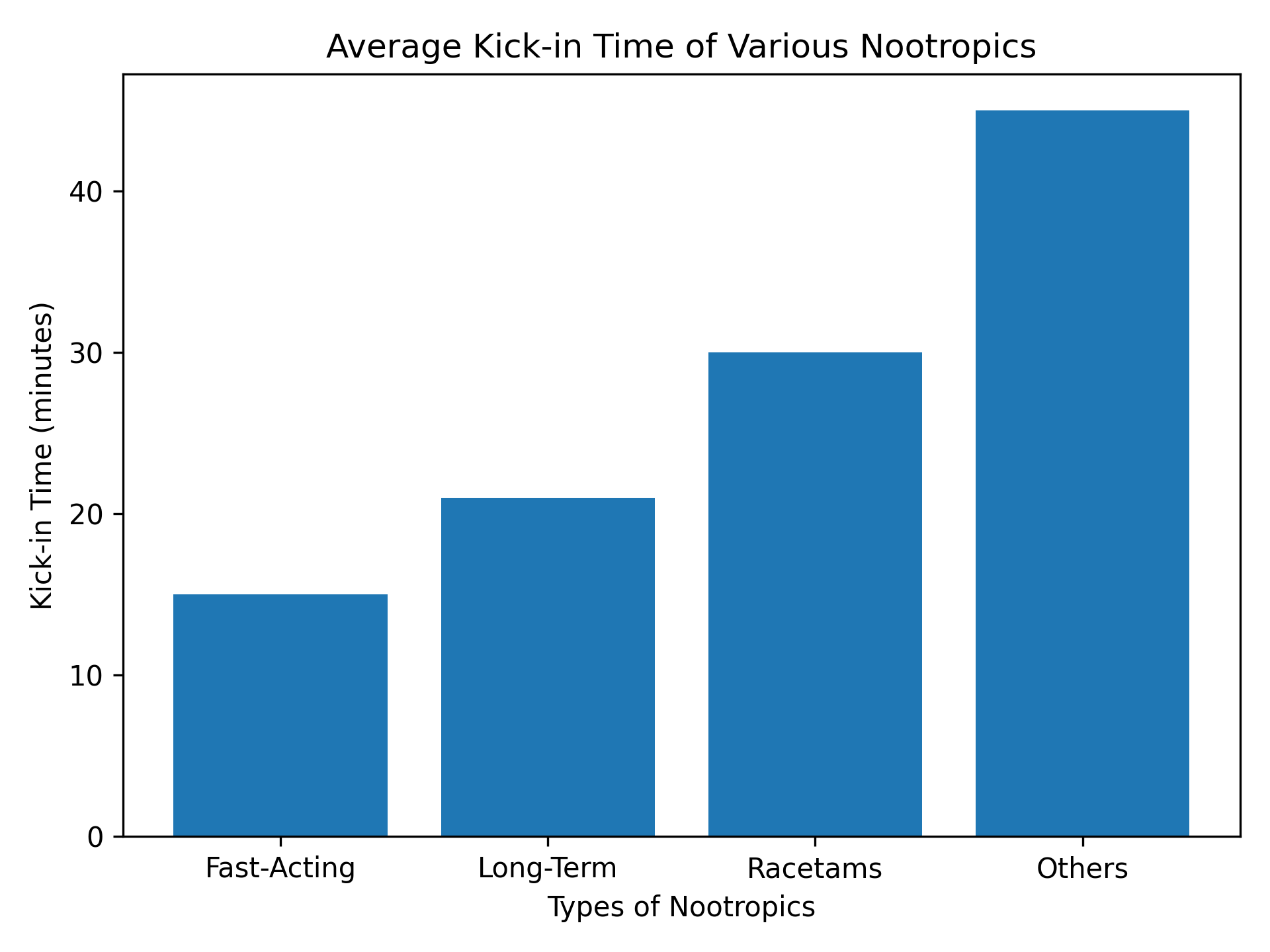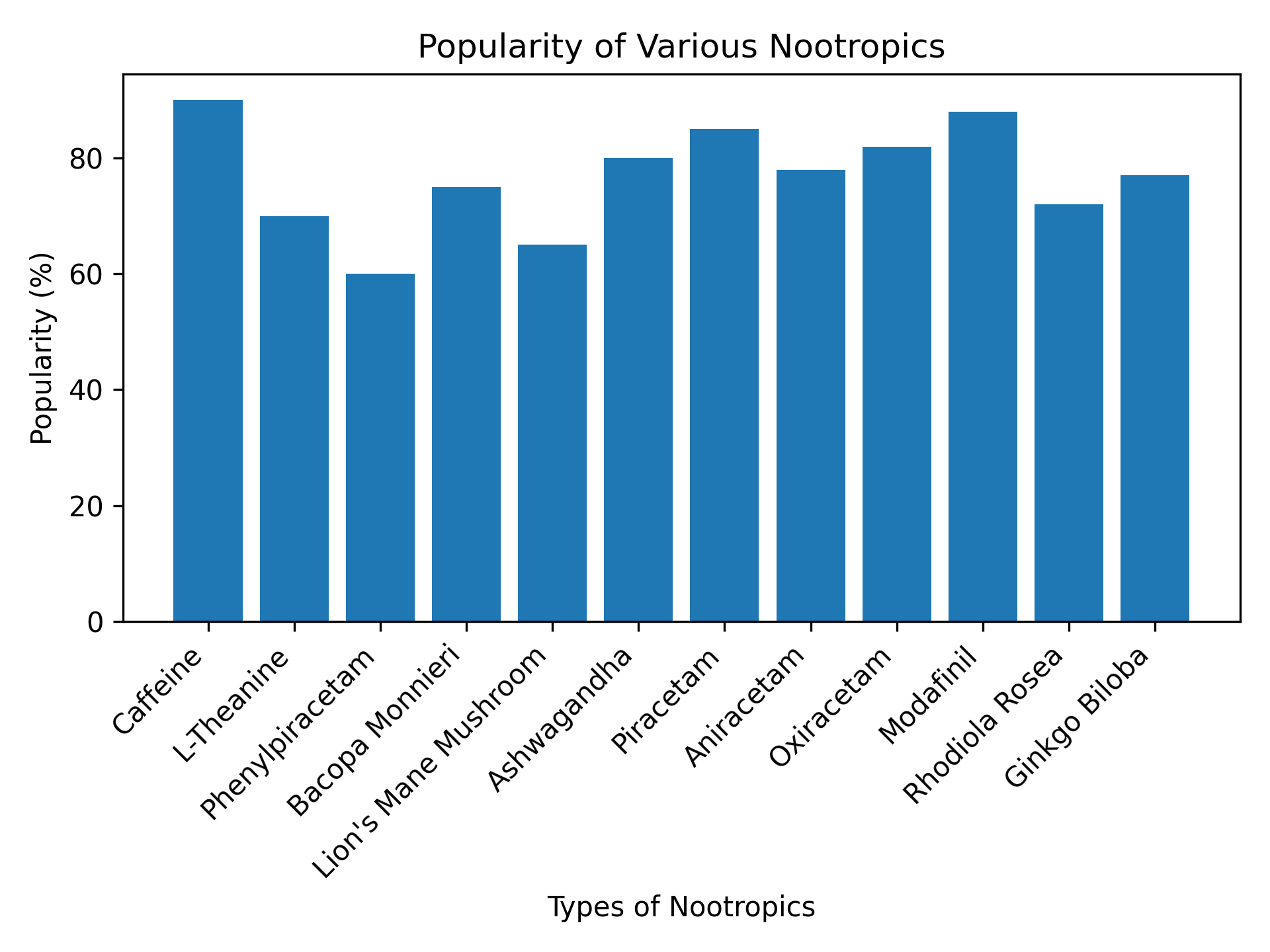In today's fast-paced world, nootropics have emerged as a beacon for cognitive enhancement. Dive into this guide to unravel the science behind these "smart drugs," their kick-in times, and fRactors influencing their effects. Whether you're a newbie or a seasoned user, this post promises enlightening insights.
TDLR:
The kick in time for Nootropics depends on various factors such as the type if Nootropic, the persons bodyweight and the state of the stomach prior to absorption.
What You'll Learn from This Guide
Kick-in Time: Explore the varying times it takes for different nootropics to manifest their effects and the science behind these timings.
Types of Nootropics: Understand the distinctions between Fast-Acting, Long-Term, Racetams, and other nootropics, and how each type influences kick-in time.
Factors Influencing Effects: Delve into the various determinants, from brain chemistry to body weight, that influence how a nootropic will affect an individual.
Natural vs. Synthetic: Compare the benefits and drawbacks of natural alternatives to their synthetic counterparts in the realm of nootropics.
Building Tolerance: Learn about the phenomenon of tolerance, how it develops over time with the continuous use of nootropics, and its impact on kick-in time.
Overview of Nootropics
Nootropics, often referred to as "smart drugs" or cognitive enhancers, are substances that can boost brain function. They have gained popularity in today's fast-paced world for their potential to improve memory, creativity, and motivation. Learn more on our homepage.
Understanding Kick-in Time
The time it takes for nootropics to start showing effects can vary widely. This section delves into the average kick-in times and what factors might influence them.
Average Kick-in Time by Type

Fast-Acting Nootropics
These nootropics can elevate your mood and cognitive function within minutes. Ideal for those looking for an instant boost.
Caffeine: Found in coffee, tea, and many energy drinks, it's known for its immediate alertness effects.
L-Theanine: Often found in tea, L-Theanine can promote relaxation without drowsiness.
Phenylpiracetam: Known for its immediate cognitive-enhancing effects and increased stamina.
Long-Term Nootropics
Designed for gradual improvement, these might take weeks or even months to show noticeable effects. However, the wait is often worth the results.
Bacopa Monnieri: An herb that may improve memory and cognition over consistent use.
Lion's Mane Mushroom: Believed to support brain health over time. We recently featured Lions mane in our best nootropic mushrooms.
Ashwagandha: An adaptogen that can reduce stress and anxiety over prolonged use.
Racetams
Popular nootropics that activate neurotransmitter receptors. Their kick-in time is relatively short, making them a favorite among many.
Piracetam: The original racetam known for its cognitive-enhancing properties.
Aniracetam: Known for its anxiolytic effects and ability to enhance creativity.
Oxiracetam: Recognized for its stimulating effects and ability to improve memory.
Other Nootropics
This category encompasses various other nootropics, each with its unique kick-in time and effects.
Modafinil: A stimulant that can enhance wakefulness and alertness.
Rhodiola Rosea: An adaptogen that can help with fatigue and mental fog.
Ginkgo Biloba: An ancient plant extract known for its cognitive-enhancing properties.

Racetams are known to activate receptors for acetylcholine, a neurotransmitter responsible for attention focus and related cognitive functions. They are fast-acting and water-soluble, making them a popular choice.
Natural vs. Synthetic Nootropics
When it comes to choosing between natural and synthetic nootropics, understanding their effectiveness, potency, and safety is crucial.
Natural Alternatives: Generally have fewer side effects but might be less potent.
Synthetic Nootropics: Often more potent and have been extensively studied. However, they might come with more side effects.
What factors effect Nootropic Absorption rate?
The main factors effecting Nootporic absorption rate are the type of nootropic, brain chemsitry, body weight, and stae of the stomach.

Type of Nootropic
Nootropics, often referred to as "smart drugs" or cognitive enhancers, come in various forms, each designed to target specific areas of the brain or particular cognitive functions. The type of nootropic plays a pivotal role in determining how quickly it will manifest its effects.
- Stimulants: These are the most common type of nootropics that people are familiar with. Caffeine, found in coffee and tea, is a prime example. Stimulants can provide an almost immediate boost in alertness and energy. They work by increasing the release of neurotransmitters like dopamine and norepinephrine, which can enhance mood and energy levels.
- Adaptogens: These are natural herbs like Ashwagandha or Rhodiola Rosea that help the body adapt to stress. Their effects are more subtle and might take longer to notice, but they work by balancing the body's stress responses over time.
- Cholinergics: These nootropics, such as Piracetam or Aniracetam, influence the cholinergic system in the brain, which is responsible for memory and learning. They might take a bit longer to kick in but can have profound effects on memory enhancement.
Brain Chemistry
Every individual's brain chemistry is unique, which means the way our brains react to different substances can vary widely. Neurotransmitters, the chemical messengers in our brain, and their respective receptors play a crucial role in determining how we respond to nootropics.
- Neurotransmitter Levels: If someone naturally has lower levels of a particular neurotransmitter, they might respond more noticeably to a nootropic that increases that neurotransmitter.
- Receptor Sensitivity: Over time, with repeated use of certain substances, our brain's receptors can become less sensitive. This means that over time, one might need a higher dose of a nootropic to achieve the same effect.
Body Weight
Just as with many medications and substances, body weight can influence the absorption, distribution, and elimination of nootropics.
- Dosage and Concentration: A smaller individual might feel the effects of a nootropic more intensely than someone who weighs more, given the same dose. This is because the concentration of the drug might be higher in a person with less body mass.
- Metabolism: Body weight can influence metabolic rate. A faster metabolism might process and eliminate the nootropic quicker, potentially reducing its duration of effect.
State of the Stomach
Whether you've eaten or not can significantly influence how quickly and effectively a nootropic is absorbed into your bloodstream.
- Empty Stomach: Taking nootropics on an empty stomach can lead to faster absorption as there's no other food to interfere with the drug's absorption. However, this can also lead to a quicker peak and decline of the drug's effects.
- Full Stomach: Consuming nootropics after a meal might slow down its absorption, leading to a more prolonged and possibly milder effect. The type of food, its fat content, and its volume can all influence the drug's absorption rate.
Building Tolerance to Nootropics and Its Impact on Kick-in Time
Tolerance is a phenomenon that can significantly influence the kick-in time of nootropics. As the body becomes accustomed to a substance, not only can its effects diminish, but the time it takes for those effects to manifest can also change. Let's delve deeper into the science behind this:
Neurotransmitter Regulation and Kick-in Time
Neurotransmitters are chemical messengers that transmit signals in the brain. Their production, release, and receptor sensitivity play a pivotal role in how we feel and function.
Impact on Kick-in Time: When a person starts using a nootropic, there's often a noticeable effect as the brain responds to the sudden influx of enhanced neurotransmitter activity. Over time, with continuous use, the brain might adjust by producing fewer neurotransmitters or by reducing the sensitivity of its receptors. For instance, a nootropic that boosts dopamine might lead to a surge in mood and motivation initially. However, with prolonged use, the brain might produce less dopamine or the dopamine receptors might become less responsive. As a result, the user might not only need a higher dose to achieve the same effect but might also experience a delay in the onset of these effects.
Metabolic Adaptations and Their Influence on Kick-in Time
Metabolism refers to how the body processes substances, including how quickly they're absorbed into the bloodstream and how they're eliminated.
Impact on Kick-in Time: Initially, the body might take longer to metabolize a new substance, leading to a quicker and more pronounced effect. However, with repeated exposure, the body can become more efficient at processing the nootropic. This means that the substance might be cleared from the bloodstream faster, leading to a shorter duration of effect and potentially a longer kick-in time. This adaptation might require the user to consume the nootropic more frequently or in larger doses to achieve the desired cognitive benefits within the same timeframe.
Homeostatic Mechanisms and Their Role in Kick-in Time
Homeostasis is the body's way of maintaining internal stability. The brain, in its quest for balance, has mechanisms to counteract sudden changes, including those induced by nootropics.
Impact on Kick-in Time: When a nootropic is introduced, it might disrupt the brain's equilibrium, leading to noticeable cognitive enhancements. However, as the brain seeks to restore balance, it might activate compensatory mechanisms. For example, if a nootropic increases alertness by inhibiting sleep-promoting neurotransmitters, the brain might counteract this over time by increasing the production of these neurotransmitters. This tug-of-war can lead to a longer kick-in time as the brain becomes more resistant to the nootropic's effects.
How long does it take for nootropics to start working?
Most reach peak blood levels within 30-60 minutes, but some can take long term sustained use of nootorpics to get them to work. Onset varies by specific nootropic, dose, and individual.
What factors influence how quickly nootropics kick in?
Main factors are formulation, dosage, stomach contents, age, metabolism, brain chemistry, nootropic type.
How can I make sure nootropics kick in faster?
Take on empty stomach with water. Favor liquids, powders, sublinguals. Start low, increase dose gradually. Pair faster and slower nootropics. Get good sleep and avoid alcohol. Stay hydrated and exercise.
Is it safe to take multiple nootropics together?
Generally safe in thoughtful stacks starting with low doses. Research interactions. Avoid overstimulating mixes. Consult doctor if new side effects occur with combinations.


